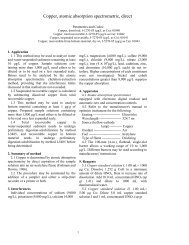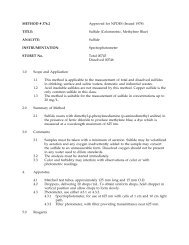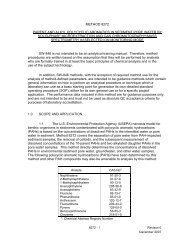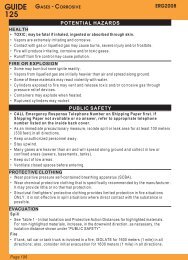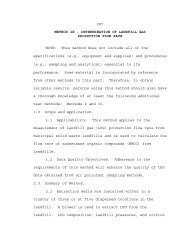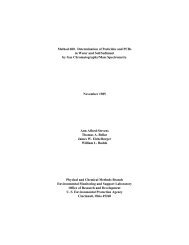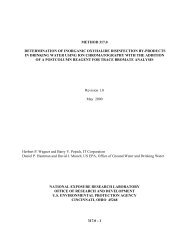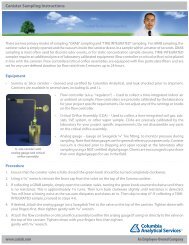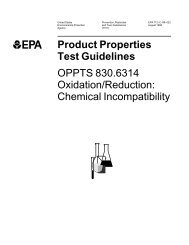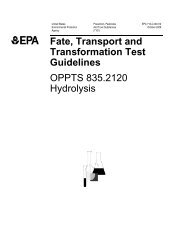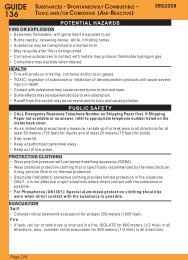View Actual EPA Method 8081A (PDF File)
View Actual EPA Method 8081A (PDF File)
View Actual EPA Method 8081A (PDF File)
Create successful ePaper yourself
Turn your PDF publications into a flip-book with our unique Google optimized e-Paper software.
columns. Table 2 lists average retention times and method detection limits (MDLs) forthe target analytes in water and soil matrices, using narrow-bore capillary columns. TheMDLs for the components of a specific sample are dependent upon the nature ofinterferences in the sample matrix and may differ from those listed in Tables 1 and 2.Table 3 lists the Estimated Quantitation Limits (EQLs) for other matrices.7.3.1.3 Table 4 lists the GC operating conditions for the single-column methodof analysis.7.3.2 Dual-column analysisThe dual-column/dual-detector approach involves the use of two 30 m x 0.53 mm IDfused-silica open-tubular columns of different polarities, thus, different selectivities towards thetarget analytes. The columns are connected to an injection tee and separate electron capturedetectors.7.3.2.1 Retention times for the organochlorine analytes on dual-columns are inTable 6. The GC operating conditions for the compounds in Table 6 are given in Table7.7.3.2.2 Multi-component mixtures of Toxaphene and Strobane were analyzedseparately (Figures 5 and 6) using the GC operating conditions found in Table 7.7.3.2.3 Figure 6 is a sample chromatogram for a mixture of organochlorinepesticides. The retention times of the individual components detected in these mixturesare given in Tables 6 and 7.7.3.2.4 Operating conditions for a more heavily loaded DB-5/DB-1701 pair aregiven in Table 8. This column pair was used for the detection of multi-componentorganochlorine compounds.7.3.2.5 Operating conditions for a DB-5/DB-1701 column pair with thinner films,a different type of splitter, and a slower temperature programming rate are provided inTable 7. These conditions gave better peak shapes for Nitrofen and Dicofol. Table 6lists the retention times for the compounds detected on this column pair.7.4 Calibration7.4.1 Prepare calibration standards using the procedures in Sec. 5.0. Refer to <strong>Method</strong>8000 (Sec. 7.0) for proper calibration techniques for both initial calibration and calibrationverification. The procedure for either internal or external calibration may be used. In mostcases, external standard calibration is used with <strong>Method</strong> 8081 because of the sensitivity of theelectron capture detector and the probability of the internal standard being affected byinterferences. Because several of the pesticides may co-elute on any single-column, analystsshould use two calibration mixtures (see Sec. 3.8). The specific mixture should be selectedto minimize the problem of peak overlap.NOTE:Because of the sensitivity of the electron capture detector, the injection portand column should always be cleaned prior to performing the initialcalibration.CD-ROM <strong>8081A</strong> - 11 Revision 1December 1996



